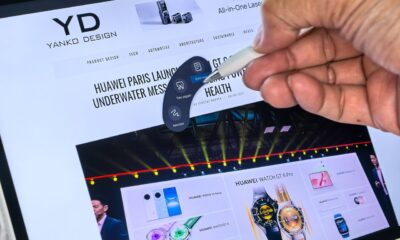Technology
Google Explains Why Pixel 10 Pro Is Limited to 15W Wireless Charging
The recently launched Google Pixel 10 Pro has drawn attention for its limitation to 15W wireless charging, unlike its larger counterpart, the Pixel 10 Pro XL, which supports 25W wireless charging. Both smartphones are equipped with Qi2 wireless charging capabilities, but Google has clarified the reasons for this disparity in charging speeds.
The Pixel 10 Pro, along with the standard Pixel 10 and Pixel 10 Pro Fold, is restricted to a maximum of 15W. In contrast, the Pixel 10 Pro XL can take advantage of the Qi2.2 standard, allowing it to achieve faster charging rates. A Google spokesperson provided insights on this issue in a statement to Android Central, highlighting that heat dissipation plays a crucial role in the performance of wireless charging.
Heat Management and Charging Limitations
The spokesperson emphasized that the larger size of the Pixel 10 Pro XL allows for better heat management, which is vital for supporting higher charging speeds. While both models feature vapor chamber cooling technology, it appears that Google deemed this insufficient for the Pixel 10 Pro to handle the demands of 25W wireless charging.
In addition to the differences in wireless charging, the Pixel 10 Pro XL also outpaces its smaller sibling in wired charging capabilities. The XL model offers 45W wired charging, enabling it to reach a 70% charge in just 30 minutes. In comparison, the Pixel 10 Pro can achieve 50% charge in the same time frame with its 30W wired charging.
Industry Comparisons and Consumer Expectations
While Google’s explanations regarding heat management may be valid, they raise questions when compared to other manufacturers. Several Chinese smartphone brands have successfully integrated faster charging technologies into smaller devices, often exceeding 100W wired and 50W wireless charging. These advancements put into perspective the limitations of the Pixel 10 Pro, making Google’s reasoning seem somewhat less convincing.
Despite these concerns, the introduction of magnets in the Pixel 10 series indicates a step forward for the brand. This enhancement is expected to improve the overall user experience, even if the removal of the Battery Share feature has disappointed some users.
As the smartphone market continues to evolve, consumers are increasingly seeking devices that offer faster charging capabilities. Google’s Pixel series faces stiff competition, particularly from manufacturers that prioritize high-performance charging technology. The choice to limit the Pixel 10 Pro to 15W wireless charging may influence potential buyers who value speed and efficiency in their devices.
-

 Education3 months ago
Education3 months agoBrandon University’s Failed $5 Million Project Sparks Oversight Review
-

 Science4 months ago
Science4 months agoMicrosoft Confirms U.S. Law Overrules Canadian Data Sovereignty
-

 Lifestyle3 months ago
Lifestyle3 months agoWinnipeg Celebrates Culinary Creativity During Le Burger Week 2025
-

 Health4 months ago
Health4 months agoMontreal’s Groupe Marcelle Leads Canadian Cosmetic Industry Growth
-

 Science4 months ago
Science4 months agoTech Innovator Amandipp Singh Transforms Hiring for Disabled
-

 Technology4 months ago
Technology4 months agoDragon Ball: Sparking! Zero Launching on Switch and Switch 2 This November
-

 Education4 months ago
Education4 months agoRed River College Launches New Programs to Address Industry Needs
-

 Technology4 months ago
Technology4 months agoGoogle Pixel 10 Pro Fold Specs Unveiled Ahead of Launch
-

 Business3 months ago
Business3 months agoRocket Lab Reports Strong Q2 2025 Revenue Growth and Future Plans
-

 Technology2 months ago
Technology2 months agoDiscord Faces Serious Security Breach Affecting Millions
-

 Education4 months ago
Education4 months agoAlberta Teachers’ Strike: Potential Impacts on Students and Families
-

 Education3 months ago
Education3 months agoNew SĆIȺNEW̱ SṮEȽIṮḴEȽ Elementary Opens in Langford for 2025/2026 Year
-

 Science4 months ago
Science4 months agoChina’s Wukong Spacesuit Sets New Standard for AI in Space
-

 Business4 months ago
Business4 months agoBNA Brewing to Open New Bowling Alley in Downtown Penticton
-

 Business4 months ago
Business4 months agoNew Estimates Reveal ChatGPT-5 Energy Use Could Soar
-

 Technology4 months ago
Technology4 months agoWorld of Warcraft Players Buzz Over 19-Quest Bee Challenge
-

 Business4 months ago
Business4 months agoDawson City Residents Rally Around Buy Canadian Movement
-

 Technology2 months ago
Technology2 months agoHuawei MatePad 12X Redefines Tablet Experience for Professionals
-

 Technology4 months ago
Technology4 months agoFuture Entertainment Launches DDoD with Gameplay Trailer Showcase
-

 Top Stories3 months ago
Top Stories3 months agoBlue Jays Shift José Berríos to Bullpen Ahead of Playoffs
-

 Technology4 months ago
Technology4 months agoGlobal Launch of Ragnarok M: Classic Set for September 3, 2025
-

 Technology4 months ago
Technology4 months agoInnovative 140W GaN Travel Adapter Combines Power and Convenience
-

 Science4 months ago
Science4 months agoXi Labs Innovates with New AI Operating System Set for 2025 Launch
-

 Technology4 months ago
Technology4 months agoNew IDR01 Smart Ring Offers Advanced Sports Tracking for $169










